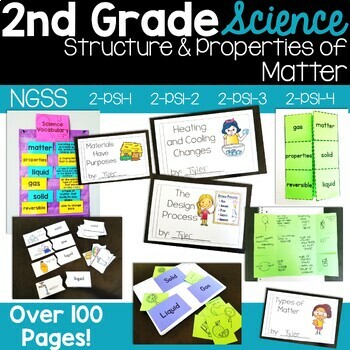2nd Grade Matter Activities States of Matter Properties of Matter NGSS Science
- PDF
What educators are saying
Also included in
- Are you struggling to find science materials for your second grade NGSS lessons? These science units include so many activities and resources that your students will love! There are mini books, vocabulary, posters, hands on activities, passages, and so much more! This is a bundle of my three 2nd GraPrice $26.00Original Price $40.75Save $14.75
Description
Are you looking for a fun way to teach 2nd grade states and properties of matter? This second grade science unit has everything you need to engage your students and learn! Students will learn about the different states of matter and how to classify the types of matter. They'll learn different properties of materials, how to build objects from sets of pieces, and how heating and cooling changes affect matter. There are many high interest activities that your students will love!
This second grade unit on structure and properties of matter aligns to NGSS* standards 2-PS1-1, 2-PS1-2, 2-PS1-3, and 2-PS1-4 and many other state standards.
It covers four topics:
- Classifying Types of Matter
- Properties of Materials
- Objects Built From Sets of Pieces
- Heating and Cooling Changes
Included are mini books, hands on science activities, non-fiction passages, practice pages, interactive notebook pages, and much more! Download the 26 page preview to see what's included in this 130 page resource!
TEACHERS LIKE YOU SAID...
⭐⭐⭐⭐⭐ I love these units. They are so fun and engaging and everything I need to teach science. I like how it includes interactive notebook pieces, vocab and experiments.
⭐⭐⭐⭐⭐ This resource is just what I was looking for! Its aligned to our standards and completely stress free! My students enjoyed the books, video links and activities associated with this bundle. I look forward to purchasing more bundles from Thrifty in Third Grade again!
Save the most by purchasing the BUNDLE! It includes all three units:
- Check out 2nd Grade NGSS Structure and Properties of Matter here
- Check out 2nd Grade NGSS Interdependent Relationships in Ecosystems here
- Check out 2nd Grade NGSS Earth's Systems: Processes that Shape the Earth here
*NGSS and Next Generation Science Standards are a registered trademark of Achieve. Neither Achieve nor the lead states and partners that developed the Next Generation Science Standards was involved in the production of, and does not endorse, this product.
©Thrifty in Third Grade
ALL RIGHTS RESERVED






